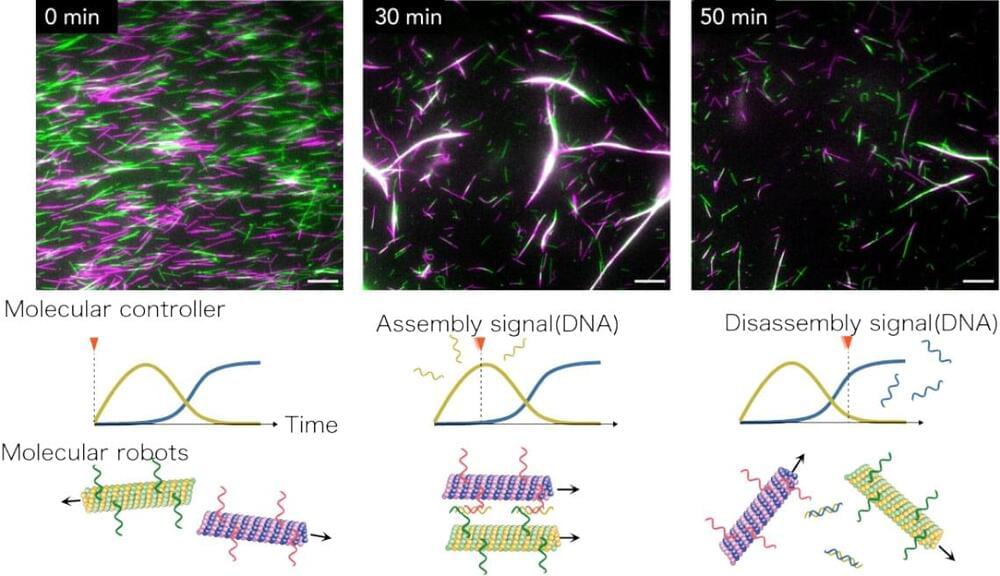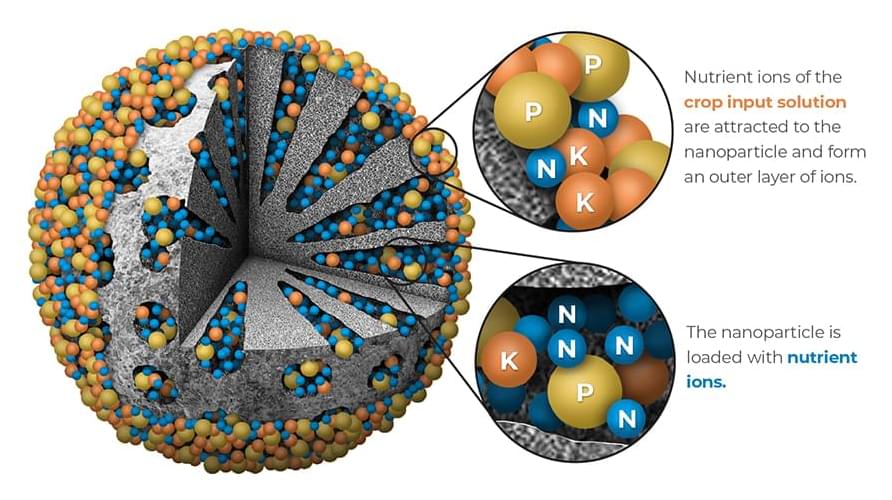Archive for the ‘nanotechnology’ category: Page 27
Jun 19, 2024
New Study Of Cancer Cells Hopes To Improve Diagnosis & Treatment
Posted by Shubham Ghosh Roy in categories: biotech/medical, nanotechnology, robotics/AI
Researchers at the Hebrew University of Jerusalem say they have developed a way to accurately predict the behavior of cancer cells, which will advance diagnosis and treatment of the disease.
The new diagnostic tool uses AI machine learning combined with nanoinformatics (observing nanomaterials) to classify cancer cell behavior in individual patient biopsies, potentially paving the way for personalized monitoring of the progression of the disease and the impact of treatments.
The study was led by Hebrew University doctoral student Yoel Goldstein and Prof. Ofra Benny from its School of Pharmacy in the Faculty of Medicine, working with Prof. Tommy Kaplan, the head of the Department of Computational Biology at the School of Engineering and Computer Science.
Jun 19, 2024
The dark side of transmission X-ray microscopy
Posted by Dan Breeden in categories: energy, nanotechnology
X-ray microscopes are essential for examining components and materials because they can be used to detect changes and details in the material. Until now, however, it has been difficult to detect small cracks or tiny inclusions in the images. By developing a new method, researchers at the Helmholtz-Zentrum Hereon are now able to visualize such changes in the nanometer regime. In particular materials research and quality assurance will profit from this development.
The team reported on their new development in the scientific journal Optica (“Nanoscale dark-field imaging in full-field transmission X-ray microscopy”).
The quality must be right. This also applies to materials science. When metal parts are welded together, you need to know whether the weld seam is any good — or whether small cracks or pores have formed inside, which could lead to failure. High-performance materials, e.g. for electrodes in electric car batteries or fuel cells, should not contain defects to allow the current to flow undisturbed.
Jun 19, 2024
Water droplets accelerate formation of mineral nanoparticles essential for life
Posted by Shubham Ghosh Roy in category: nanotechnology
Calculations and experiments reveal that water microdroplets may play role in soil formation.
Jun 17, 2024
MXenes for energy storage: Chemical imaging more than just surface deep
Posted by Dan Breeden in categories: chemistry, energy, nanotechnology
A new method in spectromicroscopy significantly improves the study of chemical reactions at the nanoscale, both on surfaces and inside layered materials. Scanning X-ray microscopy (SXM) at MAXYMUS beamline of BESSY II enables the investigation of chemical species adsorbed on the top layer (surface) or intercalated within the MXene electrode (bulk) with high chemical sensitivity. The method was developed by a HZB team led by Dr. Tristan Petit. The scientists demonstrated among others first SXM on MXene flakes, a material used as electrode in lithium-ion batteries.
Since their discovery in 2011, MXenes have gathered significant scientific interest due to their versatile tunable properties and diverse applications, from energy storage to electromagnetic shielding. Researchers have been working to decipher the complex chemistry of MXenes at the nanoscale.
The team of Dr. Tristan Petit now made a significant progress in MXene characterization, as described in their recent publication (Small Methods, “Nanoscale surface and bulk electronic properties of Ti 3 C 2 Tx MXene unraveled by multimodal X-ray spectromicroscopy”). They utilized SXM to investigate the chemical bonding of Ti 3 C 2 Tx MXenes, with Tx denoting the terminations (Tx=O, OH, F, Cl), with high spatial and spectral resolution. The novelty in this work is to combine simultaneously two detection modes, transmission and electron yield, enabling different probing depths.
Jun 17, 2024
A Scientist Says Humans Are Rapidly Approaching Singularity—and Plausible Immortality
Posted by Paul Battista in categories: biotech/medical, life extension, nanotechnology, Ray Kurzweil, robotics/AI, singularity
For over five decades, futurist Raymond Kurzweil has shown a propensity for understanding how computers can change our world. Now he’s ready to anoint nanorobots as the key to allowing humans to transcend life’s ~120-year threshold.
As he wrote—both in the upcoming The Singularity is Nearer book (set for release on June 25) and in an essay published in Wired —the merging of biotechnology with artificial intelligence will lead to nanotechnology helping “overcome the limitations of our biological organs altogether.”
As our bodies accumulate errors when cells reproduce over and over, it invites damage. That damage can get repaired quickly by young bodies, but less so when age piles up.
Jun 16, 2024
Self-assembling and disassembling swarm molecular robots via DNA molecular controller
Posted by Dan Breeden in categories: biotech/medical, nanotechnology, robotics/AI
Researchers from Tohoku University and Kyoto University have successfully developed a DNA-based molecular controller that autonomously directs the assembly and disassembly of molecular robots. This pioneering technology marks a significant step towards advanced autonomous molecular systems with potential applications in medicine and nanotechnology.
Details of the breakthrough were published in the journal Science Advances (“Autonomous assembly and disassembly of gliding molecular robots regulated by a DNA-based molecular controller”).
“Our newly developed molecular controller, composed of artificially designed DNA molecules and enzymes, coexists with molecular robots and controls them by outputting specific DNA molecules,” points out Shin-ichiro M. Nomura, an associate professor at Tohoku University’s Graduate School of Engineering and co-author of the study. “This allows the molecular robots to self-assemble and disassemble automatically, without the need for external manipulation.”
Jun 15, 2024
Going smaller to gain more
Posted by Dan Breeden in categories: nanotechnology, particle physics
Nanotechnology has arrived in the turfgrass industry. What will the presence of tiny particles mean for fertility and plant protectant applications?
Jun 14, 2024
Researchers create nanocubes forming floating checkerboards via self-assembly
Posted by Dan Breeden in categories: chemistry, engineering, nanotechnology
Researchers have engineered nanosized cubes that spontaneously form a two-dimensional checkerboard pattern when dropped on the surface of water. The work, published in Nature Communications (“Self-assembly of nanocrystal checkerboard patterns via non-specific interactions”), presents a simple approach to create complex nanostructures through a technique called self-assembly.
“It’s a cool way to get materials to build themselves,” said study co-senior author Andrea Tao, a professor in the Aiiso Yufeng Li Family Department of Chemical and Nano Engineering at the University of California San Diego. “You don’t have to go into a nanofabrication lab and do all these complex and precise manipulations.”
Each nanocube is composed of a silver crystal with a mixture of hydrophobic (oily) and hydrophilic (water-loving) molecules attached to the surface. When a suspension of these nanocubes is introduced to a water surface, they arrange themselves such that they touch at their corner edges. This arrangement creates an alternating pattern of solid cubes and empty spaces, resulting in a checkerboard pattern.
Jun 12, 2024
Quantum dot based metasurface enables two objects to exist in the same space
Posted by Dan Breeden in categories: chemistry, engineering, nanotechnology, quantum physics
In relationships, sharing closer spaces naturally deepens the connection as bonds form and strengthen through increasing shared memories. This principle applies not only to human interactions but also to engineering. Recently, an intriguing study was published demonstrating the use of quantum dots to create metasurfaces, enabling two objects to exist in the same space.
Professor Junsuk Rho from the Department of Mechanical Engineering, the Department of Chemical Engineering, and the Department of Electrical Engineering, PhD candidates Minsu Jeong, Byoungsu Ko, and Jaekyung Kim from the Department of Mechanical Engineering, and Chunghwan Jung, a PhD candidate, from the Department of Chemical Engineering at Pohang University of Science and Technology (POSTECH) employed Nanoimprint Lithography (NIL) to fabricate metasurfaces embedded with quantum dots, enhancing their luminescence efficiency. Their research was recently published in Nano Letters (“Printable Light-Emitting Metasurfaces with Enhanced Directional Photoluminescence”).
(Left) Schematic diagram of the fabrication of a luminescence-controlled metasurface using the nanoimprint lithography process. (Right) Experiment evaluating the performance of the metasurface’s luminescence control. (Image: POSTECH)


















